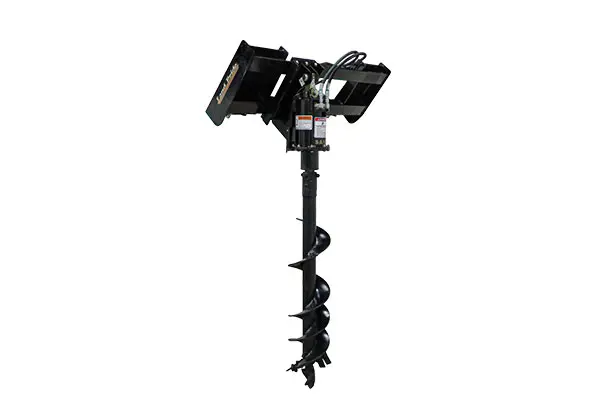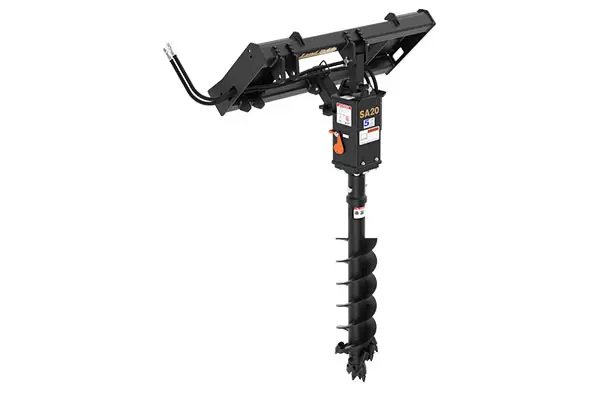Hydraulic Front Auger on a Compact Tractor
Tags : attachments | compact-tractors | kubota | kubota-b-series | landpride |Neil from Messick's here, out today with the Land Pride S 820 post auger to go on the front of some compact tractors, or machines are going to have a little less hydraulic flow. This is a unique piece that we've had a lot of interest in here lately, coming from guys that are a little disappointed in the performance of three-point hitch post augers. Remember, about a year ago or so ago I did what was one of our most popular videos of the five worst attachments for a compact tractor. One of those was a three-point hitch post auger. This is the much better alternative. We'll take a walk around here and show you exactly how this fits up to the tractor.
The biggest issue with doing an auger off the three-point hitch of a tractor is the three-point hitch's lack of downforce. They do not push down into the ground, and you're relying on the flighting on the screw to actually dig down into the ground and drill that hole. A loader, though, can do a much better job of that, using the hydraulic force of the loader, pushing that auger down into the ground. You're able to penetrate much harder ground, much more quickly. Its a lot more efficient, a lot easier to use, and a lot safer too. You'll often see guys doing some really unsafe things in order to push those augers down into the ground. In order to mount one of these up to a tractor though, you just can't snap it on your quick attach and go. There are a handful of things that you need to have set up on your machine in order to be able to accept this thing properly.
This right here is a third functioning kit, so most loaders don't have additional hydraulic outlets out on the end of them, but a third functioning kit, which is an additional valve segment back here that gives you two buttons in order to operate an additional hydraulic function out on the loader, becoming more and more popular. On some tractors, you'll hear some talk, a kind of the internet speak, this isn't something you hear in dealerships so much, of a true third function versus a diverter. Sometimes you'll see these done where the valve body is out on the loader itself, and when you push that button, what you're doing is switching from one loader function over to that diverter's hydraulic line.
A true third function is a little bit different than that, and it just taps in alongside of the loader valve, allowing you to operate these functions, while simultaneously operating the circuit. Most of the time that doesn't matter, and you can work around the difference between the true third function and the diverter, but this is one place that you definitely want that true third function. In order to operate this guy, you're going to want to be able to open this up and run the hydraulic screw, while simultaneously letting your loader drop down to the ground in order to push that thing down and drill your hole.
Now loader mounted hydraulic augers are not a new thing at all. Skid steers have been doing this for a long, long time. We sell a lot of really powerful, high capacity skid steer augers, they're going to have much larger motors out here on the end. They can take advantage of the hydraulic flow that a skid steer has, but when we get down to a smaller machine like this, we have much more limited hydraulic flow. Skid steers tend to be in the high teens on the low end for a small machine, and as much as 40 and 50 for high flow models, small tractors like this don't put nearly that much flow out this front remote.
This B Series tractor behind me here only delivers between about six and seven gallons of hydraulic flow out these third function lines. If you took that skid steer oriented auger and put it onto this machine, it would run it, but this flighting would turn extremely slow and not be super usable.
You'll notice here when we run this guy, even this one with six gallons a minute, it's very functional, but this doesn't run particularly fast. The more hydraulic flow you're going to have on that tractor, the quicker this is going to turn, the faster you're going to be able to drill those holes. Excellent for anybody looking to deck posts, put in some fences, but if you're in any kind of, say, production environment, where you really need to move quickly, probably going to want a little bit more hydraulic flow from your tractor.
Another nice thing that they do on this as well is give you multiple mounting points, so you'll see right now we have this one set up in the middle. If you go over here to the side, there's a whole other mounting point that allows you to all set the auger to the side. Again, if you go back to those post holes, and you're driving down the fence line, having it over here on the edge might be a little bit easier to give you a different sightline, or help you be a little bit closer to maybe a neighboring fence or something as you go.
I have to give a special shout out to the gentleman who's buying this tractor who happened to be watching my YouTube videos and was kind enough to allow us to show this to you today. This is not an everyday setup for us around here. We only sell a couple of these a year, but he was kind enough to let us come out here, and actually put this into the dirt for the very first time for you to be able to watch. Special shout out for letting us do this because the first time into the dirt is a special thing.
We're going to start the machine up here, and we're going to take our revs off in order to get as much hydraulic flow as we can to spin this thing. You'll see here, once I have it up and running when I take my two buttons here, I could spin my auger around. When you do this, you're going to want to generally drill your holes straight, so we're going to lift the loader up and roll the thing forward. There's a little indicator on here that helps you see vertical on this as you go up and down, so I can see that this is just about straight. We'll go ahead and run this, take it down to the ground. I'm going to float my loader and just let the weight pull itself down into the ground. It will slowly, slowly pull itself down.
Now you see that I'm starting to go slow or almost stop, so if I pull it out of float, and actually use the loader in order to let the hydraulics help assist this thing down into the ground, I could push down and move more quickly, with more power than I could otherwise.
One of the tricks of running these things is getting that hole to actually clean out, and when you lift the auger out, to not have any dirt in it. When I get here to about the top, I'm going to stop pushing down, but continue to let the auger run here for a little bit to clean the dirt out of the hole and pull as much up as possible. Now, once that's up, I'm going to lift the auger up, and bring all the dirt up, out of the hole. You see how there it'll sit on the flighting? That's how, hopefully, you get a fairly clean hole. Now, we're going to back up, kick this thing out, and just give it a little shake there, to shake the dirt off the auger. That will be the first of our post holes.
You see running that there, the flighting on this doesn't spin super fast, and that is that speed even with a lower flow motor. Keep in mind, if you're setting your tractor up to do this, you definitely want to get one of these that you have the proper hydraulic flow motor. Even if you find a used skid steer model out there, not necessarily a great idea to try and pin it on to a tractor like this and have a go at it. Generally, if you have enough hydraulic pressure, you should conceivably be able to get enough torque on this thing in order to spin it, but the flighting is going to go superslow, and you're not going to be really productive or efficient with it at all. Having run this before too, this is a really small auger. I've run a tractor mount version of this with a bigger auger before and did start to feel those torque limits getting to larger sizes. This is something that you really want to keep in mind for post holes and that kind of thing, but not something that I want to be going out and running 12-inch and 18-inch augers regularly because you'll find these hydraulic limitations fairly quickly.
More Articles

Kubota BX-80 Series with BX2816 Front Snowblower
We're out today with the Kubota BX2816 50 inch front snowblower for the BX80 series tractors. This is a unique piece that we have out here today typically we get a little frustrated when our vendors don't give us a whole lot of good information about front attachments and those kinds of things. We're going to spend some time on this one and hopefully be able to give you a little bit of information it might be hard to come by when flipping through a piece of literature.

Kubota BX4070 Cab For the BX80-Series Tractors
We've got out today a cab one of Kubota BX-series tractor. This is Kubota 's new factory cab offering for this machine. One of the things we always find frustrating about a lot of our tractor manufacturers is that they never do a very good job of giving us a lot of information about the accessories for these machines. While we're out here today we've got one of these in a lot, we're going to take an opportunity to walk around here show you the way that this thing fits onto the machine and show you some of its features and benefits.

5 Most Common Compact Tractor Attachments
I'm here today do a quick explanation for you today of the top five implements that are typically sold with the compact tractor. Tractors themselves are after all tool carriers and most or every tractor is sold with at least two or more implements. We're going to show you some of the most common ones that are typically sold with new machines.












